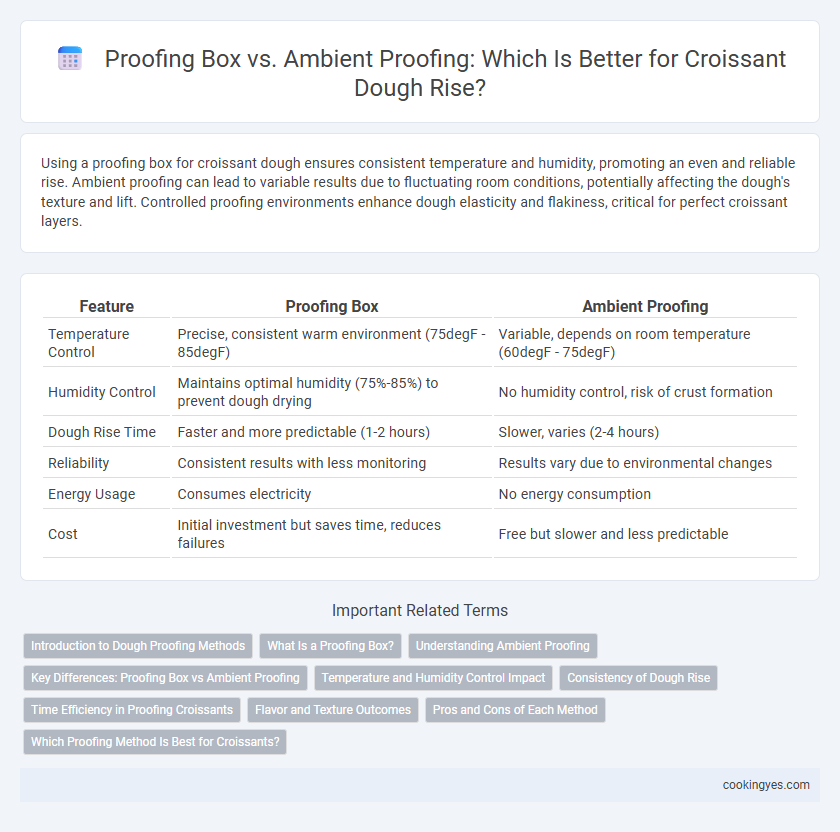Using a proofing box for croissant dough ensures consistent temperature and humidity, promoting an even and reliable rise. Ambient proofing can lead to variable results due to fluctuating room conditions, potentially affecting the dough's texture and lift. Controlled proofing environments enhance dough elasticity and flakiness, critical for perfect croissant layers.
Table of Comparison
| Feature | Proofing Box | Ambient Proofing |
|---|---|---|
| Temperature Control | Precise, consistent warm environment (75degF - 85degF) | Variable, depends on room temperature (60degF - 75degF) |
| Humidity Control | Maintains optimal humidity (75%-85%) to prevent dough drying | No humidity control, risk of crust formation |
| Dough Rise Time | Faster and more predictable (1-2 hours) | Slower, varies (2-4 hours) |
| Reliability | Consistent results with less monitoring | Results vary due to environmental changes |
| Energy Usage | Consumes electricity | No energy consumption |
| Cost | Initial investment but saves time, reduces failures | Free but slower and less predictable |
Introduction to Dough Proofing Methods
Dough proofing methods significantly impact croissant texture and rise, with proofing boxes providing controlled temperature and humidity to optimize yeast activity. Ambient proofing relies on room conditions, which can lead to inconsistent fermentation and variable dough expansion. Utilizing a proofing box ensures uniform dough proofing, resulting in a flakier, more evenly risen croissant.
What Is a Proofing Box?
A proofing box is a temperature- and humidity-controlled environment designed to optimize dough rise by maintaining consistent warmth and moisture levels, which accelerates yeast activity. Unlike ambient proofing, where dough is left out at room temperature and humidity that can vary widely, a proofing box provides precise control to produce more reliable and consistent results. This controlled setting minimizes proofing time and improves the texture and flavor development in croissants.
Understanding Ambient Proofing
Ambient proofing relies on the surrounding environment's natural temperature and humidity to allow croissant dough to rise, offering a more traditional and less controlled method. This process can lead to variable results due to fluctuations in room conditions, often requiring longer proofing times to achieve optimal dough elasticity and volume. Understanding ambient proofing is essential for bakers who aim to balance convenience with maintaining the delicate texture and layered structure characteristic of well-risen croissants.
Key Differences: Proofing Box vs Ambient Proofing
Proofing boxes provide a controlled environment with consistent temperature and humidity, significantly enhancing dough rise and texture compared to ambient proofing, which depends on fluctuating room conditions. The stable warmth and moisture inside a proofing box accelerate yeast activity and gluten development, resulting in a more reliable and uniform proof. Ambient proofing can lead to inconsistent results due to temperature variations, making it less ideal for delicate doughs like croissant layers.
Temperature and Humidity Control Impact
Proofing boxes maintain precise temperature and humidity levels, typically around 75-85degF and 75-85% humidity, which accelerates dough rise and enhances gluten development for croissants. Ambient proofing relies on room temperature, often fluctuating between 65-75degF with inconsistent humidity, leading to slower, uneven fermentation and potentially denser texture. Controlled environments in proofing boxes reduce proofing time by up to 30% and improve croissant flakiness by optimizing yeast activity and moisture retention.
Consistency of Dough Rise
A proofing box provides controlled temperature and humidity settings that ensure consistent dough rise by minimizing environmental fluctuations, resulting in uniform texture and volume. Ambient proofing depends heavily on room conditions, which can vary widely and lead to inconsistent dough development and unpredictable baking outcomes. Using a proofing box enhances repeatability in dough performance by maintaining optimal proofing conditions throughout the fermentation process.
Time Efficiency in Proofing Croissants
Proofing boxes accelerate croissant dough rise by maintaining consistent temperature and humidity levels, reducing proofing time by up to 40% compared to ambient conditions. Ambient proofing relies on fluctuating room temperatures, which can lead to uneven fermentation and longer wait times, often extending proofing by 1 to 2 hours. Utilizing a proofing box ensures a controlled environment, enhancing time efficiency and producing consistently light, flaky layers in croissants.
Flavor and Texture Outcomes
Proofing dough in a controlled proofing box enhances croissant flavor and texture by maintaining consistent temperature and humidity, resulting in a uniform rise and buttery, flaky layers. Ambient proofing often leads to uneven fermentation due to fluctuating environmental conditions, which can cause inconsistent crumb structure and less developed flavor. Utilizing a proofing box ensures optimal yeast activity and dough expansion, producing croissants with a tender interior and crisp, golden crust.
Pros and Cons of Each Method
Proofing boxes provide a controlled environment with consistent temperature and humidity, promoting even dough rise and reducing proofing time, which is ideal for precision baking like croissants. Ambient proofing relies on room temperature that can fluctuate, potentially leading to uneven fermentation and longer proofing durations. While proofing boxes enhance predictability and dough quality, they require additional equipment investment, whereas ambient proofing is cost-free but less reliable.
Which Proofing Method Is Best for Croissants?
Using a proofing box offers precise temperature and humidity control, creating the optimal environment for croissants to rise evenly and develop their characteristic flaky layers. Ambient proofing is subject to variable room conditions, which can slow fermentation and affect dough texture and flavor consistency. For consistent, professional-quality croissants, a proofing box is generally considered the best method to achieve ideal dough rise and lamination.
Proofing Box vs Ambient Proofing for Dough Rise Infographic

 cookingyes.com
cookingyes.com